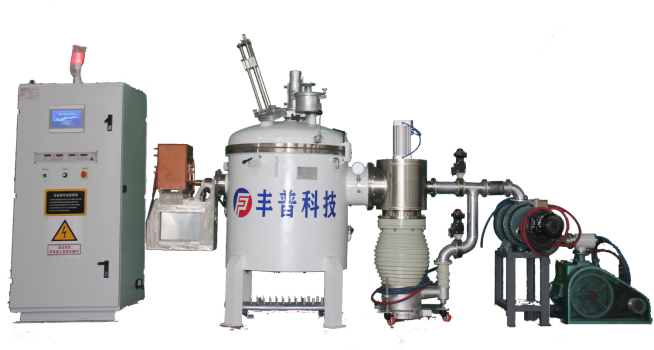Vacuum melting is suitable for various metals and alloys, especially those that require extremely high purity, quality, and performance. By melting in a vacuum environment, oxides, volatile impurities, and other unwanted elements can be effectively removed. As a result, many high-performance materials are ideal for vacuum melting. The following are some materials suitable melted in a vacuum furnace:
1. Titanium and Titanium Alloys
Titanium and its alloys are widely used in aerospace, chemical, and medical fields due to their excellent corrosion resistance, light weight, and high strength. However, titanium is highly reactive with oxygen under normal atmospheric conditions, forming oxides that degrade its performance. Therefore, vacuum melting effectively prevents oxidation, ensuring high purity and superior performance of titanium and its alloys.
Applications: Aerospace engine components, aircraft structural materials, medical implants, chemical industrial parts, etc.

2. Nickel and Nickel Alloys
Nickel-based alloys (e.g., Inconel, Hastelloy) are critical materials in aerospace, petrochemical, and nuclear industries due to their excellent performance in high-temperature, highly corrosive environments. Vacuum melting helps remove gas impurities (such as hydrogen, nitrogen, oxygen) and other contaminants from nickel alloys, ensuring uniformity and high performance.
Applications: High-temperature alloys, engine parts, turbine blades, chemical reactors, etc.
3. Tantalum and Tantalum Alloys
Tantalum is a metal with a very high melting point, excellent corrosion resistance, and good thermal stability. However, it is prone to oxidation during conventional melting. Due to its high melting point, tantalum must be melted in a vacuum or inert atmosphere to avoid oxidation, preserving its properties. Vacuum melting ensures high purity and uniformity of tantalum.
Applications: Chemical vessels in high-temperature and high-pressure environments, electronic components, aerospace materials, etc.
4. Aluminum and Aluminum Alloys
Although aluminum has a relatively low melting point, it is easily oxidized during the melting process, especially in conventional furnaces. Vacuum melting effectively removes oxygen, preventing the formation of oxide films on the surface of aluminum. Additionally, it helps remove other impurities in aluminum alloys, improving their quality.
Applications: High-precision aluminum alloys, automotive parts, aerospace equipment, electronic products, etc.
5. Niobium and Niobium Alloys
Niobium is a metal with excellent oxidation resistance, often used in high-temperature and high-pressure applications. Since niobium alloys are used in high-temperature melting and ultra-high-temperature applications, vacuum melting technology ensures their required high purity and uniform performance.
Applications: Aerospace, nuclear energy, superconducting materials, etc.
6. Lead and Lead Alloys
Lead is often used in high-precision lead alloy production during vacuum melting, especially for applications requiring high mechanical performance and corrosion resistance. Vacuum melting removes impurities in lead, enhancing its quality, particularly its purity.
Applications: Batteries, electronic components, radiation shielding materials, etc.
7. Intermetallic Compounds and High-Temperature Alloys
Some intermetallic compounds (e.g., Ni3Al, TiAl, FeAl) and high-temperature alloys are also suitable for vacuum melting. These materials are commonly used in extreme environments and require high-temperature resistance, corrosion resistance, and strength. Vacuum melting removes oxides and impurities, ensuring high purity in the alloys.
Applications: High-temperature alloys, aerospace, nuclear reactors, automotive engines, etc.
8. Rare Metals (e.g., Zirconium, Hafnium)
Zirconium (Zr) and hafnium (Hf) are high-temperature and corrosion-resistant metals commonly used in nuclear reactors, spacecraft, and high-temperature equipment. They are prone to oxidation during conventional melting, so vacuum melting prevents oxidation and ensures their stability and performance in high-temperature environments.
Applications: Nuclear reactor components, aerospace, chemical industry, etc.
9. Chromium and Chromium Alloys
Chromium is widely used in high-temperature alloys, particularly in fields requiring resistance to high temperatures and corrosion. Since chromium tends to oxidize during melting, vacuum melting effectively prevents oxidation, ensuring the quality of the final alloy.
Applications: High-temperature alloys, corrosion-resistant materials, electronic components, etc.
10. Steel and High-Alloy Steel
Vacuum melting plays a crucial role in the production of high-alloy steels (such as tool steel, stainless steel, mold steel). In a vacuum, gas impurities and oxides in steel can be removed, reducing contaminants and improving mechanical properties, corrosion resistance, and high-temperature performance.
Applications: High-strength steel, tool steel, mold steel, precision machinery, cutting tools, etc.
11. Precious Metals (e.g., Gold, Silver, Platinum, Palladium)
Precious metals can achieve higher purity through vacuum melting. In particular, when handling gold, silver, platinum, and palladium, vacuum melting helps remove impurities and avoid oxidation. Due to the high cost of these metals and their specialized applications, vacuum melting offers better quality control.
Applications: Jewelry manufacturing, high-precision electronic components, catalysts, etc.
12. High-Purity Iron
For high-purity iron or high-iron alloys, vacuum melting effectively removes impurities and gases, ensuring very high purity. This high-purity iron is commonly used in superconducting materials, special steels, and high-performance materials.
Applications: Superconducting materials, special steels, precision machinery, etc.
Characteristics of Metals and Alloys Materials Suitable Melted in a Vacuum Furnace:
- High Melting Points: Vacuum melting can effectively control and process high-melting-point metals and alloys (e.g., tungsten, molybdenum, tantalum), which are generally unsuitable for conventional furnaces.
- High Purity Requirements: Vacuum melting removes impurities and gaseous contaminants (such as oxygen, nitrogen, hydrogen), making it ideal for materials requiring high purity.
- Oxidizable Materials: For metals that are prone to oxidation (e.g., titanium, aluminum, tungsten), vacuum melting prevents oxidation and preserves the metal’s quality.
- High-Temperature Applications: Vacuum melting is suitable for alloys and metals used in high-temperature environments, providing better material stability and performance.
Summary of Materials Suitable Melted in a Vacuum Furnace:
Vacuum melting is mainly used for metals and alloys that require high purity and high performance. Metals like titanium, nickel, tantalum, and alloys, are materials that are commonly Melted in a Vacuum Furnace. By melting in a vacuum environment, impurities are effectively removed, and oxidation reactions are minimized. This ensures the reliability and stability of metals in various extreme applications.
A vacuum melting furnace is a high-end metallurgical device that melts metals or alloys in a vacuum environment. By creating a vacuum inside the furnace, it effectively controls issues like oxidation, volatilization, and contamination, resulting in higher purity metals or alloys.


